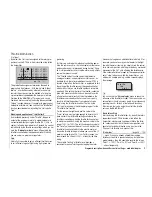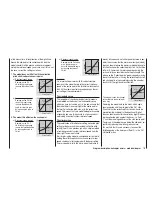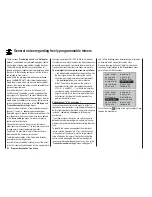
92
Program description: wing mixers – fi xed-wing model
part of the elevator signal to the fl ap servos. The mixer
direction must be set so that the fl aps move down when
up-elevator is applied, and vice versa.
Simultaneously pressing the
cd
or
ef
buttons of the
right-hand touch-key (
CLEAR
) resets an altered value
to 0%.
The “usual” settings for this mixer are in the low two-digit
range.
elev
¼
aile
(Elevator
¼
aileron)
This mixer allows the ailerons to reinforce the elevator
response in the same way as the previous mixer.
Simultaneously pressing the
cd
or
ef
buttons of the
right-hand touch-key (
CLEAR
) resets an altered value
to 0%.
The adjustment range is +/- 150%. For this mixer the
“usual” settings are again in the low two-digit range.
fl ap
¼
elev
(Flap
¼
elevator)
This inter-action between the fl aps, ailerons and elevator
is used to control the glide angle on the landing ap-
proach. Optionally the butterfl y setting can also be used
without the airbrakes or spoilers; nowadays this is very
commonly used for sports and competition aircraft.
Note:
If your model features full-span (strip) ailerons which
also double as camber-changing fl aps, the two mix-
ers “Brake
¼
aileron” and “Brake
¼
elevator” can be
combined for glide path control. In this case up-fl ap is
applied, but the fl aps can still be controlled as ailerons.
Elevator pitch trim compensation is generally required.
If you have programmed aileron differential, the re-
sponse of the ailerons will inevitably be adversely
affected by the extreme “up” defl ection of the ailerons
in the butterfl y setting, because the differential travel
reduces or entirely suppresses the down-aileron de-
fl ection. However, the “up” travel of the ailerons is also
greatly restricted because they are already at or close to
their “up” end-point. The remedy here is to apply “dif-
ferential reduction”, which is explained in its own section
later.
elev
¼
fl ap
(Elevator
¼
fl ap)
The fl aps can be used to enhance the effect of the el-
evator in tight turns and aerobatics, and this mixer feeds
servos move together for the landing approach; the
mixer ratio can be set to any value in the range -150%
to +150%.
Simultaneously pressing the
cd
or
ef
buttons of the
right-hand touch-key (
CLEAR
) resets an altered value
to 0%.
Note:
It can also be useful to defl ect both ailerons up slightly
when the airbrakes are extended; in most cases this
signifi cantly reduces the risk of a tip-stall.
Combination of the “Brake
¼
NN *” mixers:
“Crow” or “Butterfl y” setting
If you have set up all three airbrake mixers for your
model, it is then possible to program a special confi gura-
tion known as the “
crow
” or “
butterfl y
” arrangement for
glide path control. In the butterfl y setting
both ailerons
are defl ected up
by
a moderate amount
, and
both fl aps
down by the maximum possible amount
. The third mixer
provides elevator trim to counteract any unwanted pitch
trim change and maintain the model’s airspeed at a
safe level. This is necessary to avoid the danger of the
model slowing up excessively; if the landing approach is
started too soon, and has to be extended by retracting
the airbrakes again, the model could then stall abruptly.
* NN = Nomen Nominandum (name to be stated)
Summary of Contents for mx-16 HOTT
Page 7: ...7 For your notes...
Page 37: ...37 For your notes...
Page 41: ...41 For your notes...
Page 45: ...45 For your notes...
Page 51: ...51 For your notes...
Page 55: ...55 For your notes...
Page 81: ...81 For your notes...
Page 103: ...103 For your notes...
Page 133: ...133 For your notes...
Page 141: ...141 For your notes...
Page 161: ...161 For your notes...
Page 173: ...173 For your notes...
















































